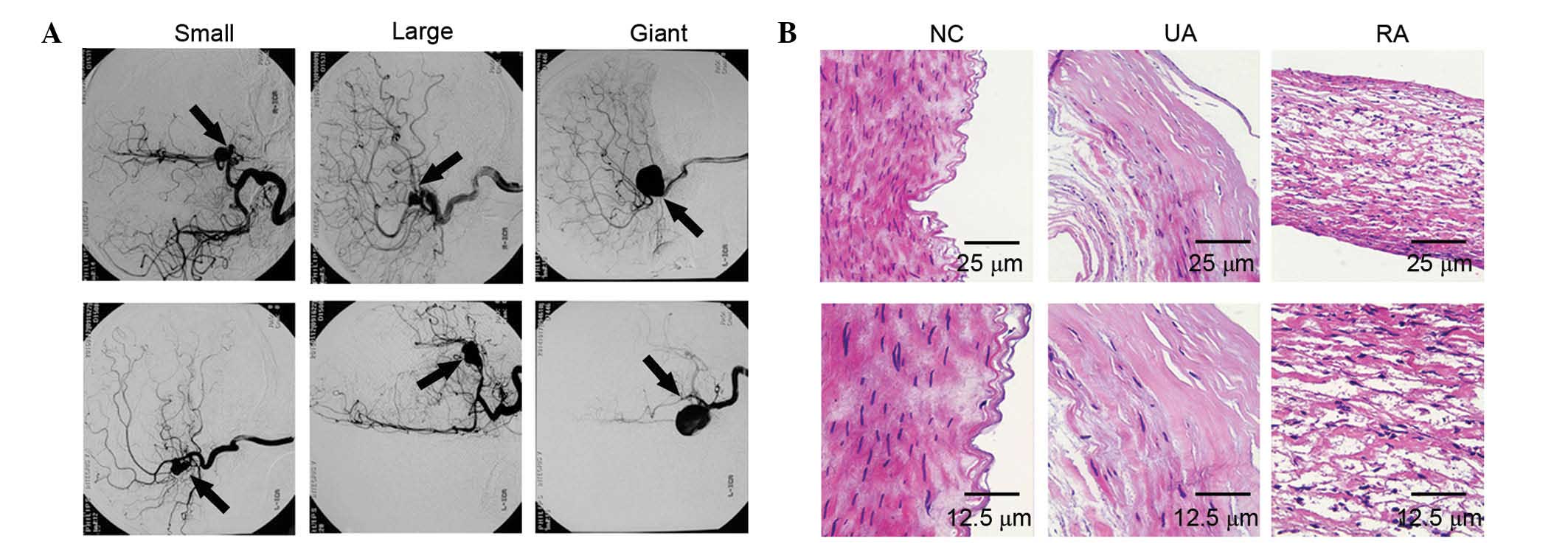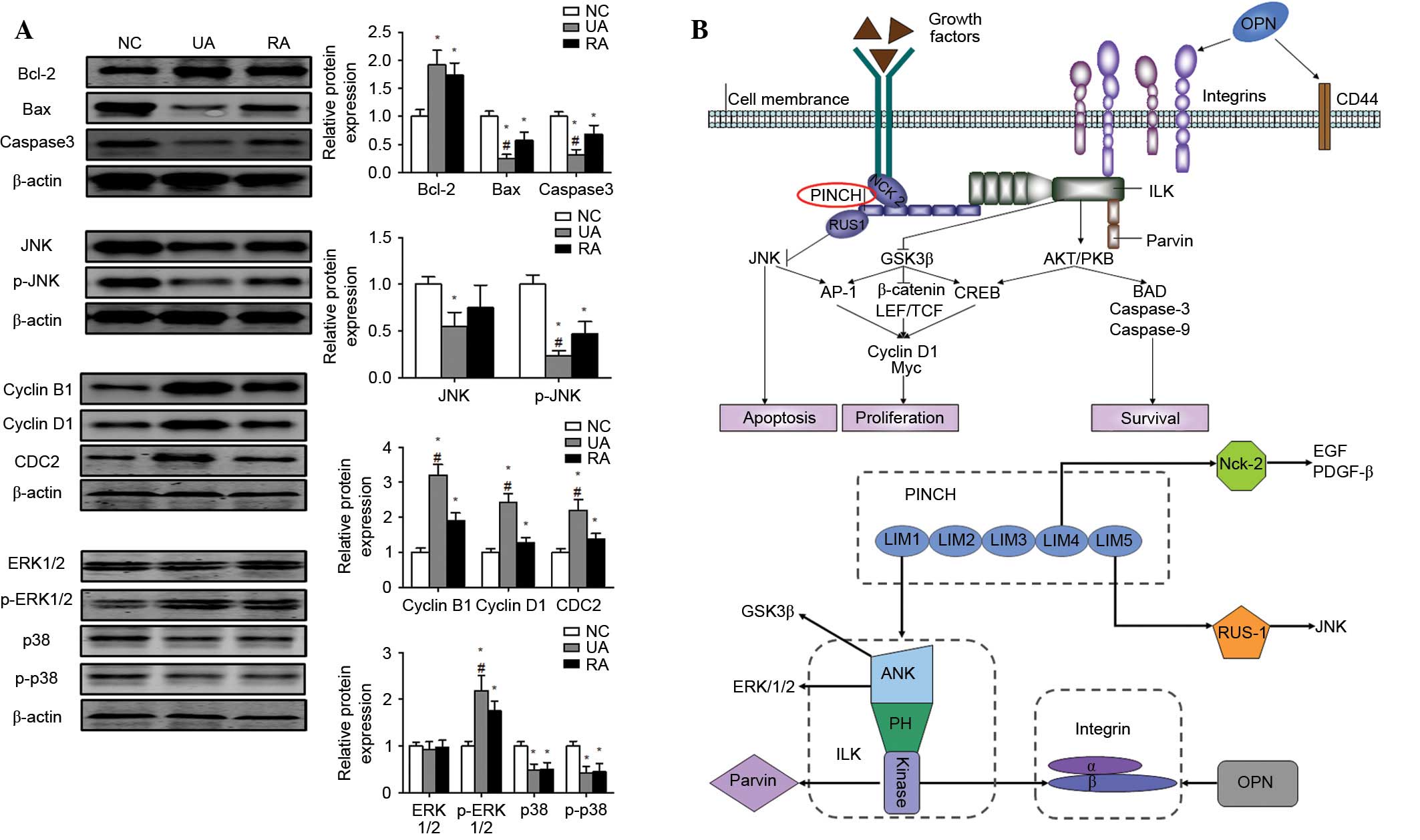|
1
|
Chalouhi N, Ali MS, Jabbour PM,
Tjoumakaris SI, Gonzalez LF, Rosenwasser RH, Koch WJ and Dumont AS:
Biology of intracranial aneurysms: Role of inflammation. J Cereb
Blood Flow Metab. 32:1659–1676. 2012. View Article : Google Scholar : PubMed/NCBI
|
|
2
|
Orz Y and AlYamany M: The impact of size
and location on rupture of intracranial aneurysms. Asian J
Neurosurg. 10:26–31. 2015. View Article : Google Scholar : PubMed/NCBI
|
|
3
|
Starke RM, Chalouhi N, Jabbour PM,
Tjoumakaris SI, Gonzalez LF, Rosenwasser RH, Wada K, Shimada K,
Hasan DM, Greig NH, Owens GK and Dumont AS: Critical role of TNF-α
in cerebral aneurysm formation and progression to rupture. J
Neuroinflammation. 11:772014. View Article : Google Scholar : PubMed/NCBI
|
|
4
|
Nordon IM, Hinchliffe RJ, Holt PJ, Loftus
IM and Thompson MM: Review of current theories for abdominal aortic
aneurysm pathogenesis. Vascular. 17:253–263. 2009. View Article : Google Scholar : PubMed/NCBI
|
|
5
|
Raux M, Patel VI, Cochennec F,
Mukhopadhyay S, Desgranges P, Cambria RP, Becquemin JP and
LaMuraglia GM: A propensity-matched comparison of outcomes for
fenestrated endovascular aneurysm repair and open surgical repair
of complex abdominal aortic aneurysms. J Vasc Surg. 60:858–863.
2014. View Article : Google Scholar : PubMed/NCBI
|
|
6
|
Watanabe Y, Kuratani T, Shirakawa Y,
Torikai K, Shimamura K and Sawa Y: Hybrid endovascular repair of a
dissecting thoracoabdominal aortic aneurysm with stent graft
implantation through the false lumen. J Vasc Surg. 59:264–267.
2014. View Article : Google Scholar : PubMed/NCBI
|
|
7
|
Wiebers DO, Whisnant JP, Huston J III,
Meissner I, Brown RD Jr, Piepgras DG, Forbes GS, Thielen K, Nichols
D, O'Fallon WM, Peacock J, Jaeger L, Kassell NF, Kongable-Beckman
GL and Torner JC: International Study of Unruptured Intracranial
Aneurysms Investigators: Unruptured intracranial aneurysms: Natural
history, clinical outcome, and risks of surgical and endovascular
treatment. Lancet. 362:103–110. 2003. View Article : Google Scholar : PubMed/NCBI
|
|
8
|
Molyneux AJ, Kerr RS, Birks J, Ramzi N,
Yarnold J, Sneade M and Rischmiller J: ISAT Collaborators: Risk of
recurrent subarachnoid haemorrhage, death, or dependence and
standardised mortality ratios after clipping or coiling of an
intracranial aneurysm in the international subarachnoid aneurysm
trial (ISAT): Long-term follow-up. Lancet Neurol. 8:427–433. 2009.
View Article : Google Scholar : PubMed/NCBI
|
|
9
|
Li Y, Dai C, Wu C and Liu Y: PINCH-1
promotes tubular epithelial-to-mesenchymal transition by
interacting with integrin-linked kinase. J Am Soc Nephrol.
18:2534–2543. 2007. View Article : Google Scholar : PubMed/NCBI
|
|
10
|
Liang X, Sun Y, Schneider J, Ding JH,
Cheng H, Ye M, Bhattacharya S, Rearden A, Evans S and Chen J:
Pinch1 is required for normal development of cranial and cardiac
neural crest-derived structures. Circ Res. 100:527–535. 2007.
View Article : Google Scholar : PubMed/NCBI
|
|
11
|
Liang X, Zhou Q, Li X, Sun Y, Lu M, Dalton
N, Ross J Jr and Chen J: PINCH1 plays an essential role in early
murine embryonic development but is dispensable in ventricular
cardiomyocytes. Mol Cell Biol. 25:3056–3062. 2005. View Article : Google Scholar : PubMed/NCBI
|
|
12
|
Li S, Bordoy R, Stanchi F, Moser M, Braun
A, Kudlacek O, Wewer UM, Yurchenco PD and Fässler R: PINCH1
regulates cell-matrix and cell-cell adhesions, cell polarity and
cell survival during the peri-implantation stage. J Cell Sci.
118:2913–2921. 2005. View Article : Google Scholar : PubMed/NCBI
|
|
13
|
Montanez E, Karaköse E, Tischner D,
Villunger A and Fässler R: PINCH-1 promotes Bcl-2-dependent
survival signalling and inhibits JNK-mediated apoptosis in the
primitive endoderm. J Cell Sci. 125:5233–5240. 2012. View Article : Google Scholar : PubMed/NCBI
|
|
14
|
Giotopoulou N, Valiakou V, Papanikolaou V,
Dubos S, Athanassiou E, Tsezou A, Zacharia LC and Gkretsi V: Ras
suppressor-1 promotes apoptosis in breast cancer cells by
inhibiting PINCH-1 and activating p53-upregulated-modulator of
apoptosis (PUMA); verification from metastatic breast cancer human
samples. Clin Exp Metastasis. 32:255–265. 2015. View Article : Google Scholar : PubMed/NCBI
|
|
15
|
Andréasson H, Wanders A, Sun XF, Willén R,
Graf W, Nygren P, Glimelius B, Zhang ZY and Mahteme H:
Histopathological classification of pseudomyxoma peritonei and the
prognostic importance of PINCH protein. Anticancer Res.
32:1443–1448. 2012.PubMed/NCBI
|
|
16
|
Zhu ZL, Yan BY, Zhang Y, Yang YH, Wang ZM,
Zhang HZ, Wang MW, Zhang XH and Sun XF: PINCH expression and its
clinicopathological significance in gastric adenocarcinoma. Dis
Markers. 33:171–178. 2012. View Article : Google Scholar : PubMed/NCBI
|
|
17
|
Holmqvist A, Gao J, Holmlund B, Adell G,
Carstensen J, Langford D and Sun XF: PINCH is an independent
prognostic factor in rectal cancer patients without preoperative
radiotherapy-a study in a Swedish rectal cancer trial of
preoperative radiotherapy. BMC Cancer. 12:652012. View Article : Google Scholar : PubMed/NCBI
|
|
18
|
Chen K, Tu Y, Zhang Y, Blair HC, Zhang L
and Wu C: PINCH-1 regulates the ERK-Bim pathway and contributes to
apoptosis resistance in cancer cells. J Biol Chem. 283:2508–2517.
2008. View Article : Google Scholar : PubMed/NCBI
|
|
19
|
Kim O, Hwangbo C, Kim J, Li DH, Min BS and
Lee JH: Chelidonine suppresses migration and invasion of MDA-MB-231
cells by inhibiting formation of the integrin-linked
kinase/PINCH/α-parvin complex. Mol Med Rep. 12:2161–2168.
2015.PubMed/NCBI
|
|
20
|
Zheng SF, Yao PS, Yu LH and Kang DZ:
Keyhole approach combined with external ventricular drainage for
ruptured, poor-grade, anterior circulation cerebral aneurysms.
Medicine (Baltimore). 94:e23072015. View Article : Google Scholar : PubMed/NCBI
|
|
21
|
Legate KR, Montañez E, Kudlacek O and
Fässler R: ILK, PINCH and parvin: The tIPP of integrin signalling.
Nat Rev Mol Cell Biol. 7:20–31. 2006. View
Article : Google Scholar : PubMed/NCBI
|
|
22
|
Wang LY, Tang ZJ and Han YZ:
Neuroprotective effects of caffeic acid phenethyl ester against
sevofluraneinduced neuronal degeneration in the hippocampus of
neonatal rats involve MAPK and PI3K/Akt signaling pathways. Mol Med
Rep. 14:3403–3412. 2016.PubMed/NCBI
|
|
23
|
Cui ZW, Xie ZX, Wang BF, Zhong ZH, Chen
XY, Sun YH, Sun QF, Yang GY and Bian LG: Carvacrol protects
neuroblastoma SH-SY5Y cells against Fe(2+)-induced apoptosis by
suppressing activation of MAPK/JNK-NF-kappaB signaling pathway.
Acta Pharmacol Sin. 36:1426–1436. 2015. View Article : Google Scholar : PubMed/NCBI
|
|
24
|
Fukuda T, Chen K, Shi X and Wu C: PINCH-1
is an obligate partner of integrin-linked kinase (ILK) functioning
in cell shape modulation, motility, and survival. J Biol Chem.
278:51324–51333. 2003. View Article : Google Scholar : PubMed/NCBI
|
|
25
|
Zhang Y, Chen K, Guo L and Wu C:
Characterization of PINCH-2, a new focal adhesion protein that
regulates the PINCH-1-ILK interaction, cell spreading, and
migration. J Biol Chem. 277:38328–38338. 2002. View Article : Google Scholar : PubMed/NCBI
|
|
26
|
Papke CL, Yamashiro Y and Yanagisawa H:
MMP17/MT4-MMP and thoracic aortic aneurysms: OPNing new potential
for effective treatment. Circ Res. 117:109–112. 2015. View Article : Google Scholar : PubMed/NCBI
|
|
27
|
Wolak T, Sion-Vardi N, Novack V, Greenberg
G, Szendro G, Tarnovscki T, Nov O, Shelef I, Paran E and Rudich A:
N-terminal rather than full-length osteopontin or its C-terminal
fragment is associated with carotid-plaque inflammation in
hypertensive patients. Am J Hypertens. 26:326–333. 2013. View Article : Google Scholar : PubMed/NCBI
|
|
28
|
Jono S, Peinado C and Giachelli CM:
Phosphorylation of osteopontin is required for inhibition of
vascular smooth muscle cell calcification. J Biol Chem.
275:20197–20203. 2000. View Article : Google Scholar : PubMed/NCBI
|
|
29
|
Dahiya S, Givvimani S, Bhatnagar S,
Qipshidze N, Tyagi SC and Kumar A: Osteopontin-stimulated
expression of matrix metalloproteinase-9 causes cardiomyopathy in
the mdx model of Duchenne muscular dystrophy. J Immunol.
187:2723–2731. 2011. View Article : Google Scholar : PubMed/NCBI
|













